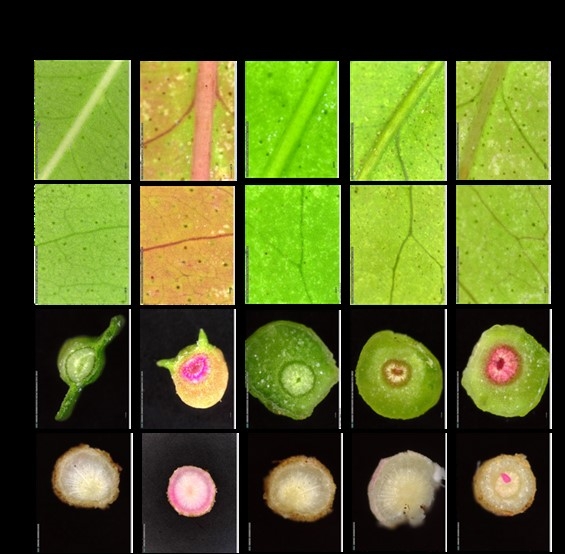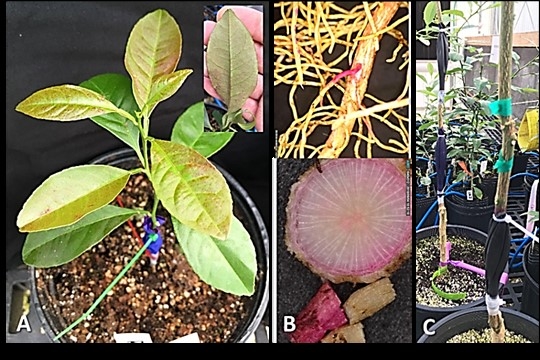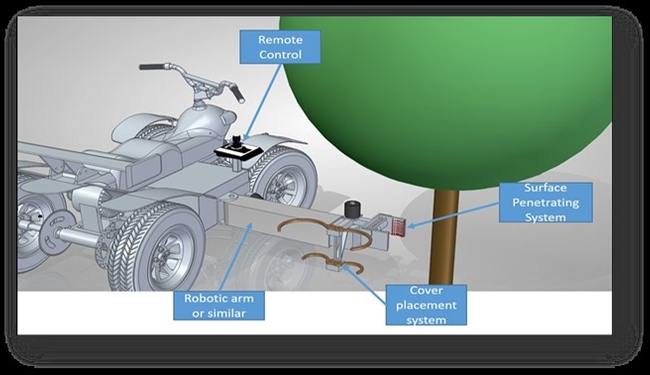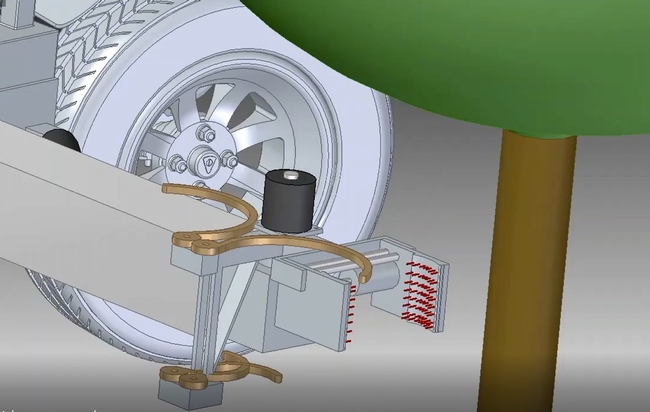An Automated Delivery System for Therapeutic Materials to Treat HLB Infected Citrus
Ozgur Batuman1 and Louise Ferguson2
¹Southwest Florida Research and Education Center, University of Florida, Immokalee, FL; 2UC Davis, Department of Plant Sciences, University of California Davis, Davis CA
Why is this research needed?
In 2005, a disease called Huanglongbing (HLB, citrus greening, was identified in Florida's commercial citrus groves. The disease is caused by a bacterium that affects all citrus cultivars by disrupting the flow of nutrients from the source of production, to the site of use, causing tree decline. HLB weakens the root system, increases early fruit and leaf drop, lowers tree productivity and fruit quality and ultimately kills the tree. The disease has spread to all the major production regions in Florida. Economic losses have exceeded more than $4 billion dollars. Currently, more than 95% of Florida's trees are infected. There is currently no cure for the disease.
Efforts to control HLB have been unsuccessful as the bacterium cannot be cultured, literally grown, in a petri dish, and once in the plant it proliferates within the citrus phloem. Phloem is the system that transports sugars from their site of production, the leaves, to plant parts that use sugars, the roots or flowers.Phloem transport is generally downward but can be upward as well.
Once the HLB bacterium is in a tree's phloem it has the potential to infect the entire tree. It is exceedingly difficult to introduce any control agent into the phloem with the conventional control methods of foliar spraying or soil drenching.
Thus far, no treatment preventing HLB infection, or controlling the bacterium once within the tree, has been developed. Potential chemicals are being investigated, but in order to test them, direct or indirect phloem delivery, where the bacterium proliferates, is needed. Therefore, an effective method of delivering an effective volume of theraputics into the phloem is needed to evaluate potential treatments.
What is the focus of this project?
Our project focuses on developing a method of delivering therapeutic liquid materials, bactericides, microbial metabolites, RNAi, or biologicals, into the citrus vascular tissues, both the xylem which conducts water and nutrients upward from the roots and the phloem, which conducts sugars and other metabolic products downward from the leaves. We are investigating diffusion, trunk punctures with a surrounding liquid reservoir for passive uptake and infusion, low pressure active injections. We are focusing on these methods as foliar sprays and root drenches have not been successful phloem delivery methods.
Who will be doing the research?
The project is led by plant pathologist Dr. Ozgur Batuman with colleagues at the Southwest Florida Research and Education Center (SWFREC) at University of Florida in Immokalee. This four-year project will also study the citrus vascular system with a multidisciplinary research team including UF Plant Pathologists Drs. Nabil Killiny and Amit Levy at Lake Alfred, SWFREC UF Plant Physiologist Ute Albrecht, Citrus Horticulturist Fernando Alferez, Precision Ag. Engineer Yiannis Ampatzidis, Agricultural and Natural Resources Economist Tara Wade, University of California-Davis Extension Specialist Louise Ferguson and Texas A&M-Kingsville Citrus Center Plant Pathologist Veronica Ancona as well as number of graduate students, postdocs, and Florida, Texas and California citrus industry members.
How will this research be done?
Our earlier research involving comparisons of delivery methods including foliar sprays, soil drenching and trunk injection determined Needle-Assisted Trunk Infusion (NATI) was the best potential delivery method (Figure.1). In initial experiments, using NATI, 1 ml of rhodamine (1%) dye was injected into the trunks of one-year-old citrus seedlings. A visible red color, indicative of rhodamine uptake and movement, was detected in the upper-most leaves within 30-60 min and an increase in color intensity was observed within 24 hours. Similar results were observed in two-year-old grafted Valencia plants within 48 hours. If the NATI delivery method can be automated, large numbers of trees could be treated quickly. Once the delivery method has been developed, implementation will be tested with potential treatments developed within other research projects.
Our proposed automated delivery would consist of a robotic arm with several modules at the end of the arm, installed on an ATV or tractor. One module with needles would grip and puncture the trunk, a second module would wrap a reservoir around the trunk below the punctures and third module would fill the reservoir. (Figure 2). Hopefully, a robotic arm plus automated system will be inexpensive enough for growers to purchase and simple enough to use.
Another approach is disease prevention; application pf prophylactic chemicals that prevent infection. In this scenario our system would be used treat healthy young trees with bactericides or boost their immune system. When infected by the ACP the bacterium would either be killed or suppressed, perhaps below the level that harms tree growth and productivity. This option is analogous to the vaccinations that prevent diseases in humans and animals.
What are the greatest challenges and opportunities.
The greatest challenge is successful phloem delivery. The greatest opportunity is that, if successful, we will have developed a method that will allow much more precise deliver of theraputics to citrus trees. For example, if an effective phloem delivery method is developed, it could be used to control insects that feed on citrus plant parts. Or, it could be used to deliver growth regulators, perhaps nutrients and carbohydrates, to roots and fruits to increase growth, development and fruit quality; much like an intravenous injection functions in an animal.
Among the questions we hope to investigate are:
- When, what kind of, and what amount of therapeutics can be applied by NATI?
- At what frequency?
- What type of citrus tree: cultivar, age, infected, healthy is the best for treatment by NATI?
- Can we kill the bacterium? How and when to assess a change in bacteria titer after treatment?
- When will become available and be economically feasible for growers?
Figure 1. Distribution of rhodamine (red dye; 1%) applied by NATI in various tissues (left) of grafted and non-grafted young citrus plants grown in the greenhouse (right). Photos taken 2 weeks after the treatments. Treatments and tissues observed are indicated. Yo = year-old.
Figure 2. Projected automated delivery system (ADS); an ATV with extendable arm with NATI and the cover placement systems on the arm guided onto the tree trunk (upper panel), and closeup of NATI and cover placement system (panel below).
Acknowledgement
The United States Department of Agriculture National Institute of Food and Agriculture (USDA-NIFA) Grant # 2019-70016-29096.
For more information, please visit this project's dedicated website:
https://swfrec.ifas.ufl.edu/programs/citrus-path/automated-delivery/



